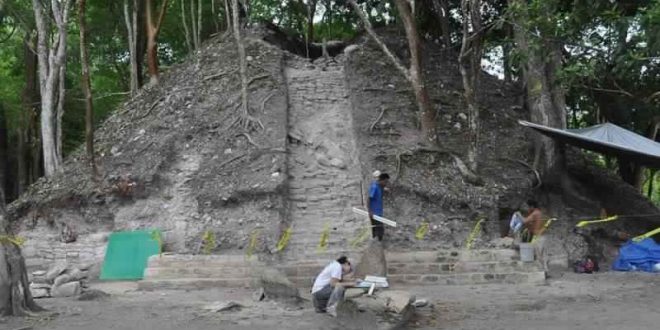Researchers have uncovered what may be the largest royal tomb found in more than a century of work on Maya ruins in Belize.
Archaeologists working in Belize have been digging through the remains of the city of Xunantunich, a ceremonial and administration centre on the Mopan river which controlled parts of western Belize around 700AD.
They recently discovered a royal tomb buried up to 8m under rubble and grit filling a central staircase inside one of the city’s temples.
It has turned out to be one of the biggest tombs yet uncovered in Belize. And its owner — a man of about 25 years age — is yet to be identified.
But it is the discovery of two engraved stone panels that has historians excited.
They are the vital missing pieces of a disassembled ceremonial staircase, torn from the regional capital of Caracol after its king was overthrown.
The engravings, which told the story of the snake dynasty from its founding to the rise of its last king, were scattered throughout the region. Many were ‘re-purposed’. Some were lost.
These may turn out to be among the most important of them all.
The hieroglyphics tell the tale of Kanu’l Ajaw: “king of the place where snakes abound”. It details the founding of the snakehead dynasty at Calakmul.
They also reveal a story of wounded pride and ancient censorship.
Researcher Dr Christophe Helmke says translations indicate Snake Lord Kan II of the city of Caracol had defeated the lord of Naranjo (15km west of Xunantunich) some time before 642AD. The captured leader was then subjected to a ceremonial ball game before being sacrificed to the gods.
Naranjo eventually had its revenge, however. Caracol was in turn defeated in 680AD.
Naranjo’s new rules had a Caracol commemorative staircase detailing the story of the snake kings dismantled and partially reassembled on its own territory — with four stone panels deliberately left out in order to belittle the dynasty’s achievements.
One of four missing stone panels has been found in excavations at nearby Ucanal, also on the Mopan river. Another broken piece was found in Caracol itself.
How hieroglyphic panels from this dismantled staircase ended up in Xunantunich is unknown, but Dr Helmke told media they represent both the start and end of its narrative.
It details the rise of the snake kings in the city of Dzibanche before moving their capital to Calakmul, with family members ruling surrounding cities including Caracol.
It tells of how the mother Lord Khan II had been part of a marriage of allegiance between the city of Yaxha (in Guatemala) and Caracol.
The archaeologists say the panels reveal the snake dynasty was a tumultuous one. Waxaklajuun Ubaah Kan — who may have been Kan II’s half-brother — contested the crown between 630 and 640AD.
Where the recent tomb fits into this tale is not yet known. But careful study of the remains and funerary objects is expected to cast new light on its occupant’s identity.
Archaeologist Dr Jaime Jose Awe of Northern Arizona University told media an early study of the body indicates the man to have been athletic and muscular. Further study is needed to determine the cause of death.
Around him were found jaguar and deer bones, along with 13 obsidian (volcanic glass) blades and 36 ceramic bowls. A cluster of six jade beads may have belonged to a necklace.
Two caches were found cut into the base of the stairway. These contained 28 pieces of flint shaped as animals, leaves and symbols.
Unusually, the chamber had been built at the same time as the temple above it, Mr Aw said. Usually tombs in the region were later additions to an existing building.
Whether or not this is an indication of the occupant’s status is not yet known.
Xunantunich and the surrounding Mayan cities went into sudden decline about 900AD. Eventually the cities were abandoned and the forests took over.
Agencies/Canadajournal
 Canada Journal – News of the World Articles and videos to bring you the biggest Canadian news stories from across the country every day
Canada Journal – News of the World Articles and videos to bring you the biggest Canadian news stories from across the country every day



